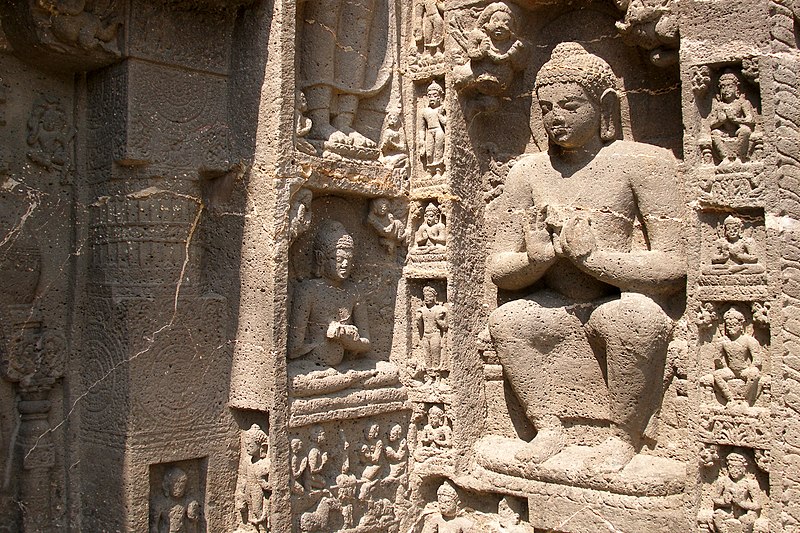The Ajanta Caves, located in Maharashtra, India, are a prime example of ancient architectural genius and intense spiritual devotion. Travelers, historians, and art aficionados from all over the world are drawn to these caves because of the stories they reveal about India’s rich cultural legacy that are carved into the horseshoe-shaped rock. Let’s explore the fascinating history, the amazing architectural feats, and the must-know travel advice for seeing the Ajanta Caves and the surrounding area.
Ajanta Caves stand as a timeless testament to India’s rich cultural legacy and artistic heritage.
A visit to the Ajanta Caves promises an enlightening experience steeped in history and spirituality with its breathtaking architecture, engaging artworks, and tranquil ambiance. It is a must-see location for tourists visiting the wonders of Maharashtra, India.

Unraveling the History:
The Ajanta Caves, situated in the Aurangabad district of Maharashtra, date back to the 2nd century BCE to the 6th century CE. These caves, numbering 30 in total, were meticulously carved into the basalt rock during the Satavahana dynasty and later patronized by various ruling dynasties, including the Vakataka and Chalukya empires.

The caves were covered with colorful murals and magnificent sculptures that told stories of mythology, the life of Buddha, and stories from the Jataka. The caves were primarily used as Buddhist monastery complexes. In addition to showcasing the artistic talent of ancient Indian artisans, these works of art provide priceless insights on the socioreligious climate of the time.
“With its awe-inspiring architecture, captivating artworks, and serene ambience, a visit to the Ajanta Caves promises an enriching experience steeped in history and spirituality, making it a must-visit destination for travelers exploring the wonders of Maharashtra, India.”
Architectural Splendor and Significance:
Characterized by their rock-cut architecture, the Ajanta Caves comprise prayer halls, monasteries, and chaitya-grihas (Buddhist prayer halls) adorned with intricately carved pillars, magnificent sculptures, and ornate facades. The intricate detailing and architectural finesse of these caves exemplify the zenith of ancient Indian craftsmanship and architectural ingenuity.

Among the most notable caves is Cave 1, also known as the “Vihara” or monastery, adorned with captivating murals portraying the life of Buddha and his previous incarnations. Cave 26, renowned for its elaborate sculptures and ornate facade, stands as a testament to the artistic brilliance of the ancient craftsmen.

Journeying to Ajanta Caves:
Reaching the Ajanta Caves is relatively convenient, with Aurangabad serving as the nearest major city and transportation hub. Aurangabad is well-connected by air, rail, and road networks to major cities like Mumbai, Pune, and Delhi.
From Aurangabad, travelers can hire taxis or opt for state-run buses to reach the Ajanta Caves, located approximately 100 kilometers northeast of the city. The journey offers scenic vistas of the Maharashtra countryside, characterized by lush greenery and rugged terrain.

Best Time to Visit:
The ideal time to explore the Ajanta Caves is during the winter months, from October to March, when the weather remains pleasant and conducive for sightseeing. During this period, temperatures are moderate, making it comfortable for travelers to explore the caves and the surrounding areas.
Places of Nearby Interest:
While exploring the Ajanta Caves, travelers can also visit the Ellora Caves, another UNESCO World Heritage Site located approximately 100 kilometers from Aurangabad. The Ellora Caves, renowned for their rock-cut temples and monasteries spanning Hindu, Buddhist, and Jain faiths, offer a captivating glimpse into India’s religious and architectural diversity.
Hotels Near Ajanta Caves:
Aurangabad offers a wide range of accommodation options catering to different budgets and preferences. From luxury hotels to budget guesthouses and homestays, travelers can find suitable lodging options in close proximity to the Ajanta Caves and other tourist attractions.
Some popular accommodation choices in Aurangabad include:
- Taj Hotels
- The Lemon Tree Hotel
- Hotel Vivanta Aurangabad
- Hotel Keys Select
For travelers seeking a more immersive experience, there are also options for heritage stays and boutique hotels that offer a glimpse into the rich cultural heritage of Maharashtra.



